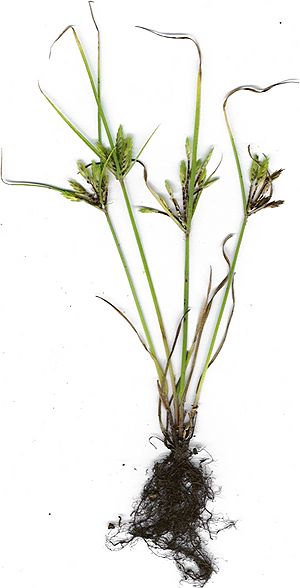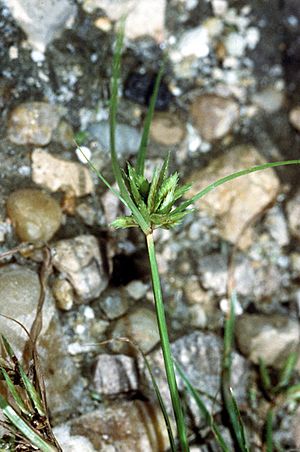Annual sedge facts for kids
Quick facts for kids Annual sedge |
|
|---|---|
 |
|
| Scientific classification | |
| Genus: |
Cyperus
|
| Species: |
compressus
|
The Annual Sedge, also known as Cyperus compressus, is a type of grass-like plant. It is found in many warm parts of the world. This plant belongs to the Cyperaceae family, which includes many sedges. It is common in tropical areas of Africa, Asia, and the Americas.
In Europe, people sometimes call it "hedgehog sedge." This is because of how its flowers look. In France, it is known as "souchet comprimé." In India, its name is "mothi," and in Japan, it is called "kugugayatsuri."
What Does Annual Sedge Look Like?
The Annual Sedge usually grows to be about 0.1 to 0.75 meters (4 inches to 2.5 feet) tall. It grows in a "tufted" way, meaning it forms a clump. This plant blooms, or flowers, between May and December. Its flowers are typically green, yellow, or brown.
This sedge has many fine roots. Its stems stand straight up and are smooth. They are shaped like a triangle and are about 0.5 to 2.0 millimeters (0.02 to 0.08 inches) thick. The base of the plant is covered by loose, reddish-purple leaf sheaths.
The leaves are much shorter than the stems. They are a grayish-green color and are very narrow. Each leaf is about 1.5 to 4.0 millimeters (0.06 to 0.16 inches) wide. The plant's flowers grow in a cluster called an inflorescence. This cluster looks like an umbrella with three or four branches. These branches can be up to 8 centimeters (3 inches) long.
After the plant flowers, it forms a small, dark brown to black seed. This seed is shaped like a broad oval and has three sides. It is about 1.5 millimeters (0.06 inches) long and 1 millimeter (0.04 inches) wide.
Where Does Annual Sedge Grow?
The Annual Sedge is found across many parts of the world. It is very common in Asia, especially in countries like India, Malaysia, Pakistan, and the Philippines. You can also find it throughout much of Africa, from Egypt all the way to Zimbabwe.
In the Americas, it grows in the southern USA, Honduras, Costa Rica, and Suriname. It is also found on islands like Fiji and in New Guinea. This plant is known as a "pantropical species." This means it grows in tropical regions all over the world.
It prefers moist places. You can often see it in irrigated fields, ditches, and along the edges of streams and ponds. It also grows well in lawns. The Annual Sedge can grow in many different types of soil. It especially likes sandy, alluvial (river-deposited), and clay soils.
This plant has also spread to new areas. In Western Australia, it is found in damp spots in the Kimberley region. It also grows in Queensland, New South Wales, and the Northern Territory in Australia.


